PFT Self-Guided Tour
Welcome to a self-guided tour of Patrick F. Taylor Hall. Below are maps of the first and second floors of PFT, with tour stops indicated by the purple outlined numbers. At these locations, click the corresponding button below to read or listen to a description of the space. When you are finished reading/listening, simply click the "Top" button in the bottom right-hand corner of the screen to find the next stop. We hope you enjoy the tour!
First Floor Map
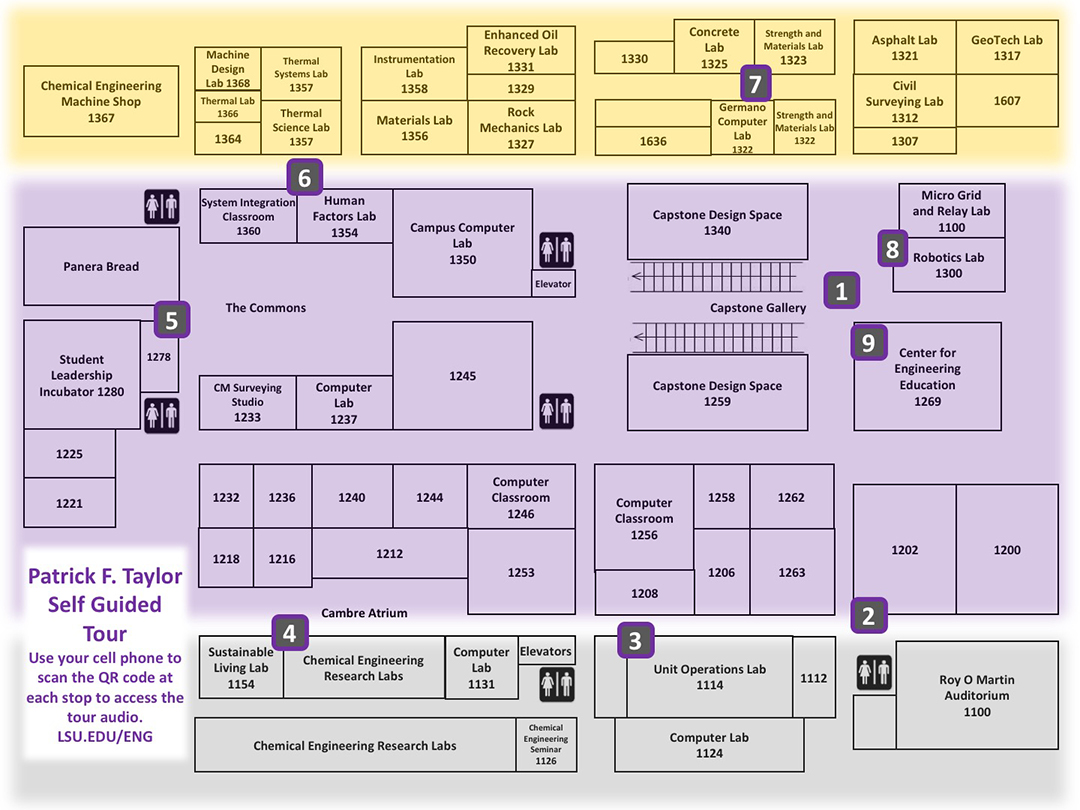
Second Floor Map
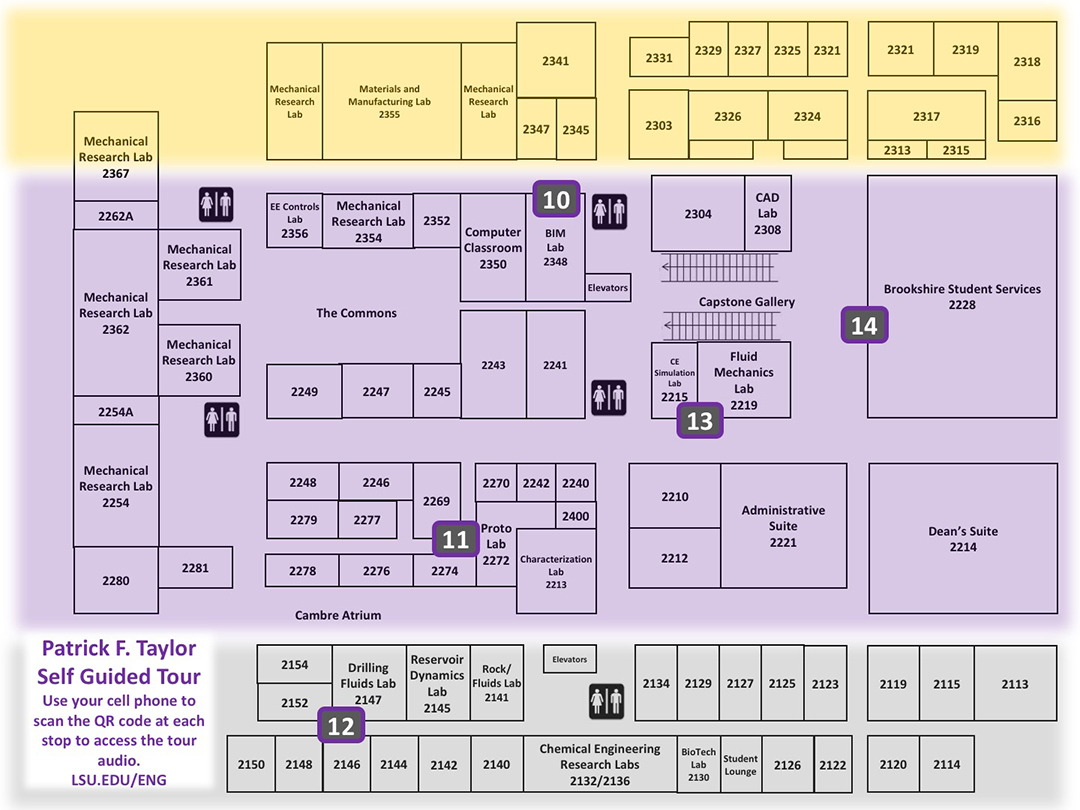
Tour Stops
1. Capstone Gallery
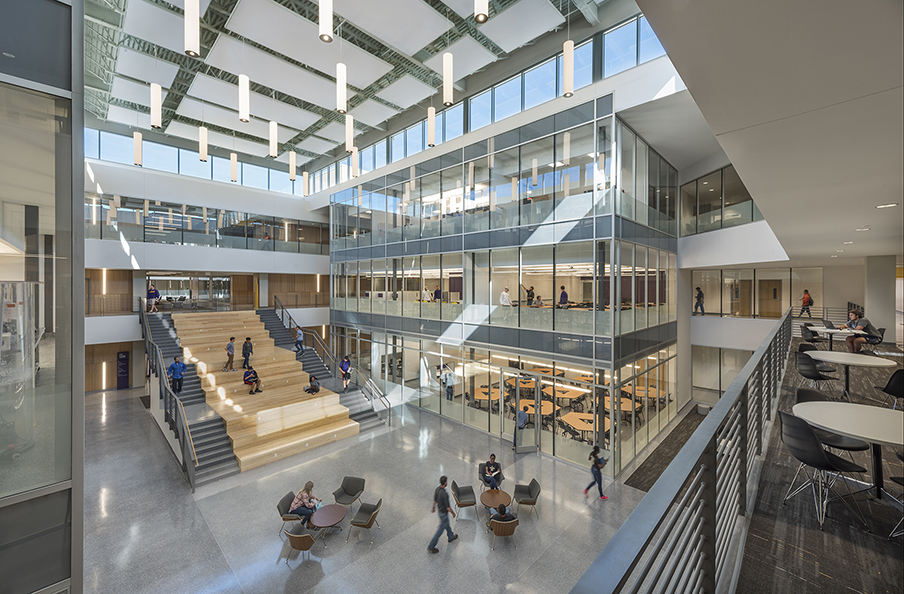
Welcome to Patrick F. Taylor Hall, home to the LSU College of Engineering. Named after 1959 petroleum engineering graduate, Patrick F. Taylor, it is the largest academic building in the state of Louisiana and one of the largest free-standing College of Engineering buildings in the United States. As a result of our recent $114-million renovation and expansion, this building is now more than 400,000 square feet and provides students and faculty with state-of-the-art classrooms and labs. It also serves as the central hub for the College of Engineering’s eight academic departments, which educate thousands of undergraduate and graduate students each year.
2. Cambre Atrium & Donor Wall
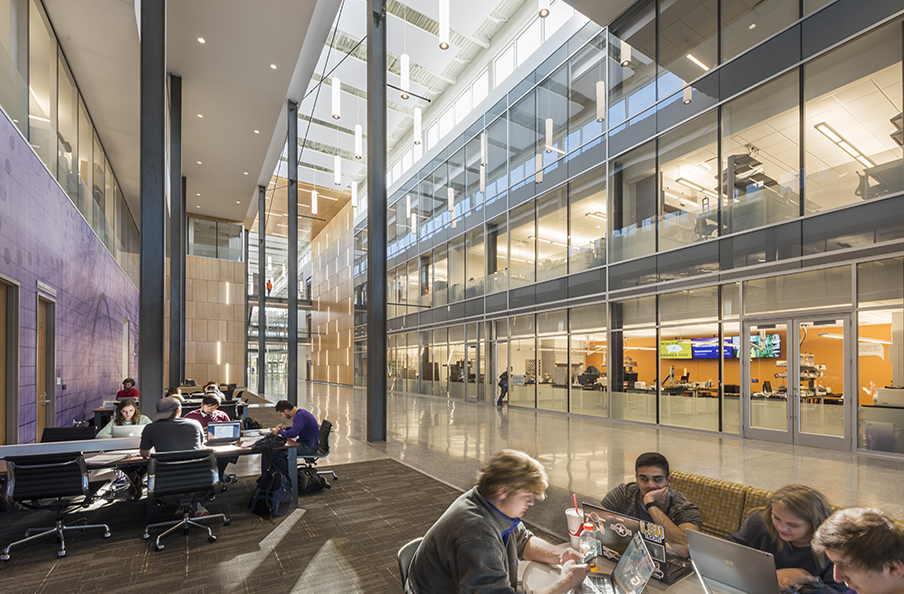 The Cambre Atrium is one of three main common spaces in Patrick F. Taylor Hall. It
connects what was the existing old building to a newly built, three-story lab annex.
A number of chemical engineering labs run the length of the Cambre Atrium on one side,
and classrooms line the other, ranging in size from about 30 seats up to 150 seats.
The largest classroom space in the building is the RoyOMartin Auditorium, which holds
up to 250 students. Across from the doors to the RoyOMartin Auditorium, you’ll find
the Donor Wall, which recognizes the names of donors and industry partners who, along
with funds from the state of Louisiana, helped make the renovation of Patrick F. Taylor
Hall possible.
The Cambre Atrium is one of three main common spaces in Patrick F. Taylor Hall. It
connects what was the existing old building to a newly built, three-story lab annex.
A number of chemical engineering labs run the length of the Cambre Atrium on one side,
and classrooms line the other, ranging in size from about 30 seats up to 150 seats.
The largest classroom space in the building is the RoyOMartin Auditorium, which holds
up to 250 students. Across from the doors to the RoyOMartin Auditorium, you’ll find
the Donor Wall, which recognizes the names of donors and industry partners who, along
with funds from the state of Louisiana, helped make the renovation of Patrick F. Taylor
Hall possible.
3. DOW Chemical Unit Operations Lab (1114)
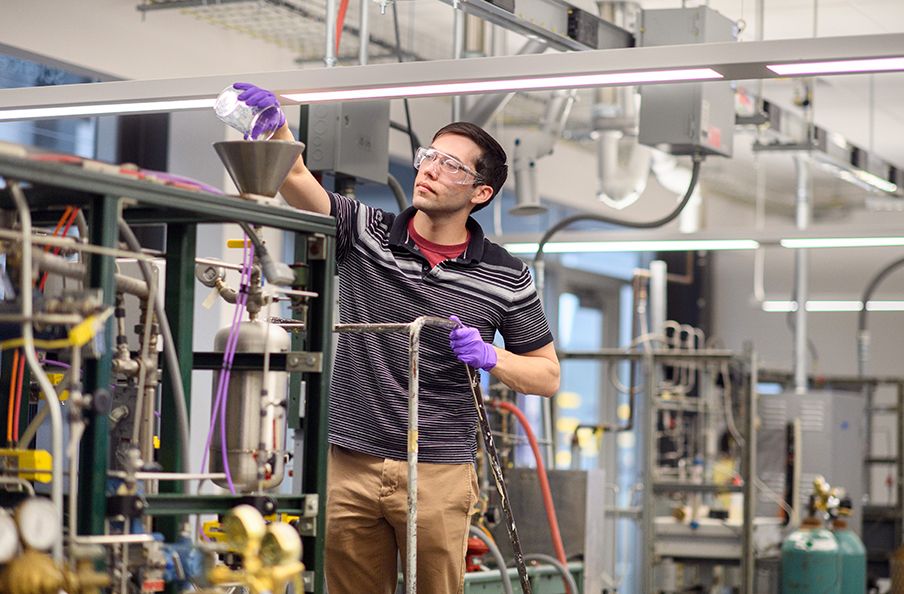 The Dow Chemical Unit Operations Laboratory is a learning lab housed within the Cain
Department of Chemical Engineering. It contains various pieces of equipment that are
designed to complete specific “unit operations.” A unit operation is a single step
in a chemical process, such as separation, crystallization, oxidation, etc. For instance,
the first machine on the left is an Ethylene Oxidation Reactor, which, as the name
suggests, oxidizes ethylene into ethylene oxide, a common compound found in laundry
detergents. Much of the equipment in this space has been donated or funded by industry
partners and gives students in the chemical engineering program valuable hands-on
experience with industry-grade equipment. To the right of the lab, is a distillation
column, which can be viewed better from the second floor. This unit separates components--water
and a series of glycols--into pure or near pure components by the differences in the
vapor pressure of the components. Students have the chance to work on a distillation
unit that is a true commercial analog of those they will be expected to operate when
they enter the workforce as chemical engineers. This unit would not be out of place
at a commercial pharmaceutical or specialty chemical facility that operates in the
commercial world. It is built to those specifications and design criteria. Students
will physically interact with equipment in their junior-year lab and then learn to
run the equipment from the adjacent control room as seniors.
The Dow Chemical Unit Operations Laboratory is a learning lab housed within the Cain
Department of Chemical Engineering. It contains various pieces of equipment that are
designed to complete specific “unit operations.” A unit operation is a single step
in a chemical process, such as separation, crystallization, oxidation, etc. For instance,
the first machine on the left is an Ethylene Oxidation Reactor, which, as the name
suggests, oxidizes ethylene into ethylene oxide, a common compound found in laundry
detergents. Much of the equipment in this space has been donated or funded by industry
partners and gives students in the chemical engineering program valuable hands-on
experience with industry-grade equipment. To the right of the lab, is a distillation
column, which can be viewed better from the second floor. This unit separates components--water
and a series of glycols--into pure or near pure components by the differences in the
vapor pressure of the components. Students have the chance to work on a distillation
unit that is a true commercial analog of those they will be expected to operate when
they enter the workforce as chemical engineers. This unit would not be out of place
at a commercial pharmaceutical or specialty chemical facility that operates in the
commercial world. It is built to those specifications and design criteria. Students
will physically interact with equipment in their junior-year lab and then learn to
run the equipment from the adjacent control room as seniors.
4. BASF Sustainable Living Lab (1154)
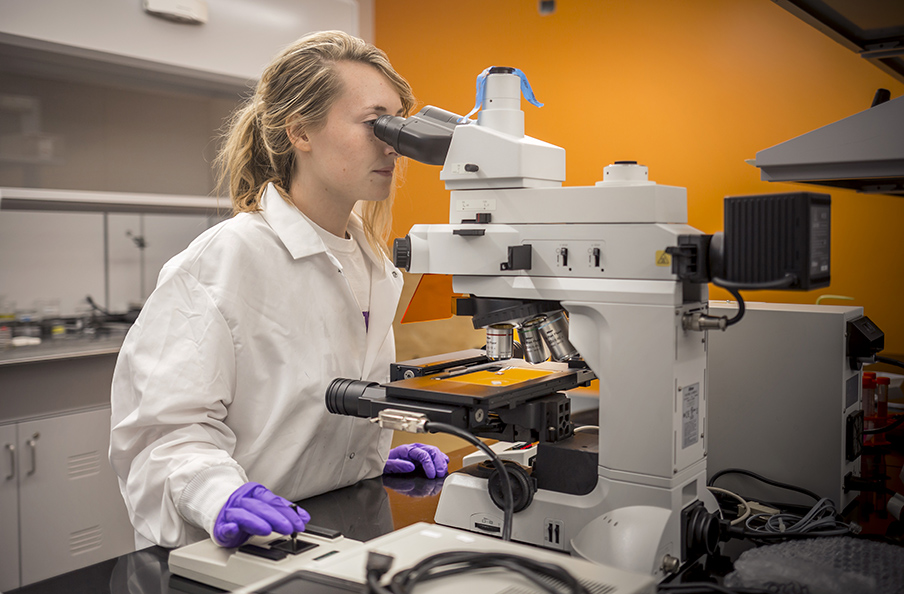 The BASF Sustainable Living Laboratory was funded by a $1 million donation from BASF.
The flooring, paint, and ceiling in this lab are all made from BASF products. The
lab space is dedicated to research investigating sustainable solutions to meet global
challenges. The current researcher-in-residence, Dr. Jimmy Lawrence, studies and develops
new functional polymers and nanoscale composites for healthcare, energy, environmental,
and other industrial applications.
The BASF Sustainable Living Laboratory was funded by a $1 million donation from BASF.
The flooring, paint, and ceiling in this lab are all made from BASF products. The
lab space is dedicated to research investigating sustainable solutions to meet global
challenges. The current researcher-in-residence, Dr. Jimmy Lawrence, studies and develops
new functional polymers and nanoscale composites for healthcare, energy, environmental,
and other industrial applications.
5. The Commons (1278)
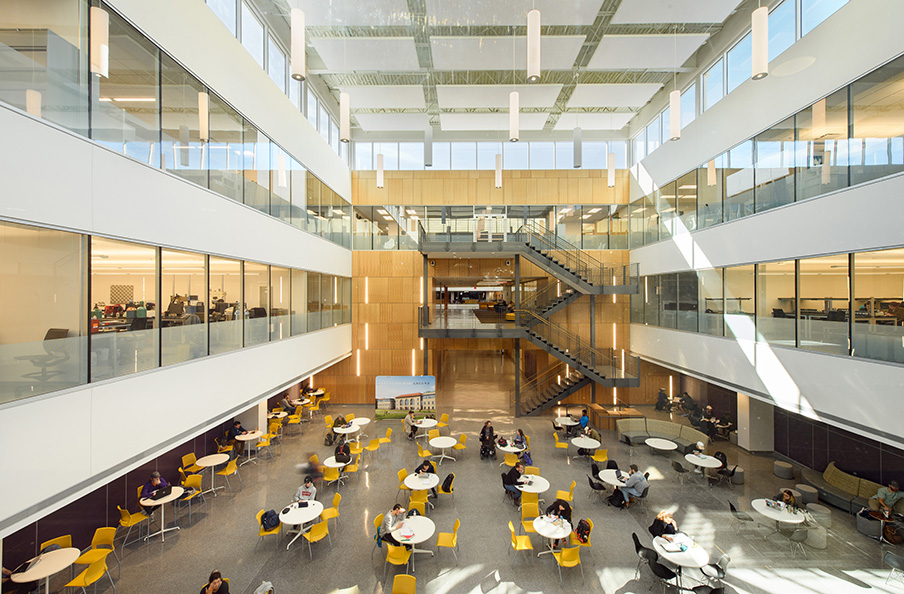
This atrium space is aptly named “The Commons” and serves as the main gathering space for everyone in Patrick F. Taylor Hall. Students frequent this space between classes, not only because of the Panera Bread, but also because of the nearby Dow Student Leadership Incubator, which serves as a meeting and storage space for the more than 40 student organizations that are part of our college.
6. Mechanical Engineering Labs (1354)
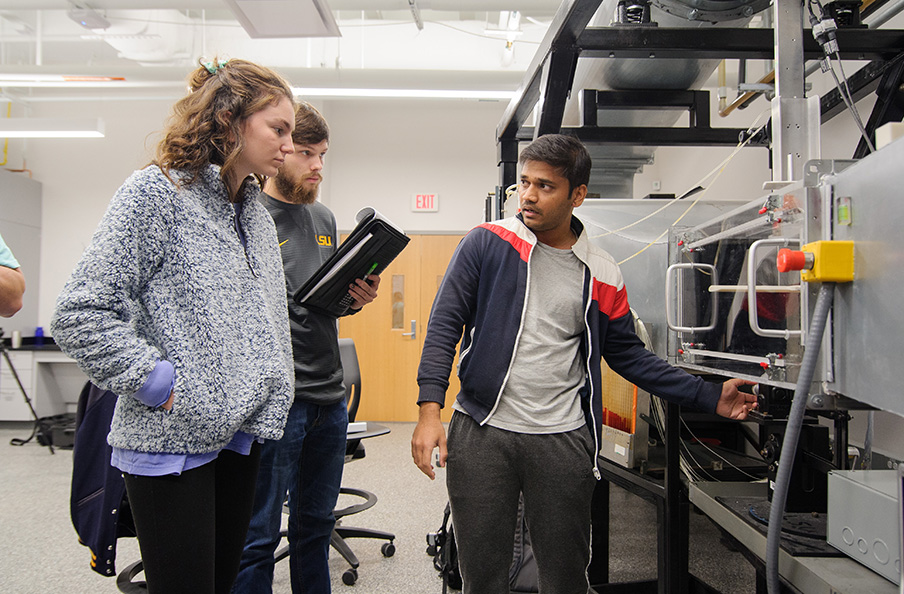
This section of Patrick F. Taylor Hall is home to many student-focused lab spaces for mechanical and industrial engineering, including the human factors, thermal systems, materials, and instrumentation labs. Within these labs, you will find equipment like a wind tunnel, tensile strength testers, and 3D-motion analysis systems.
mechanical engineering labs audio
7. Civil Engineering Labs (1323)
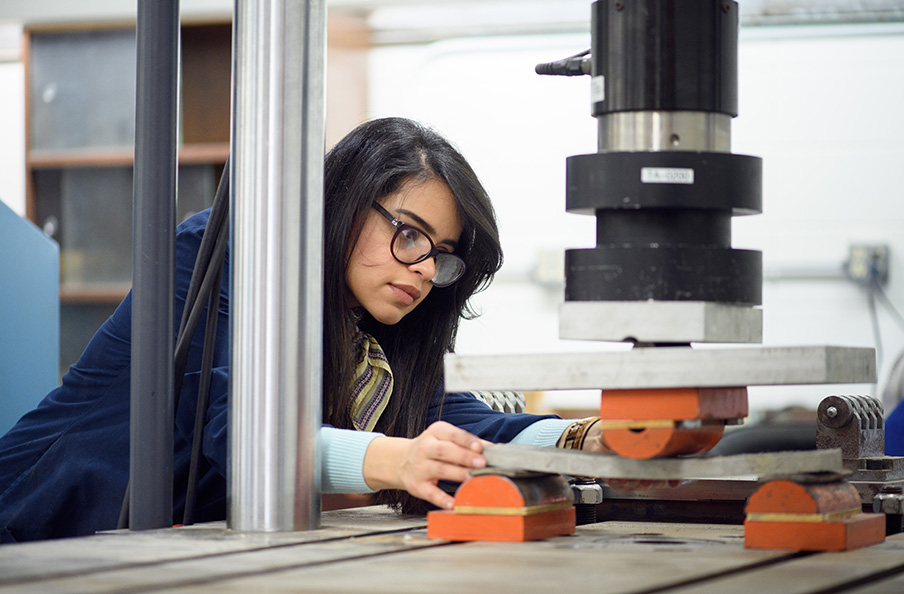
In this section of Patrick F. Taylor Hall, you will find most of our civil engineering student labs. Here, our students test concrete for strength and damage, test and create asphalt, test the chemical composition and strength of soils, and study the strength of metal and timber.
8. Robotics Lab (1300)
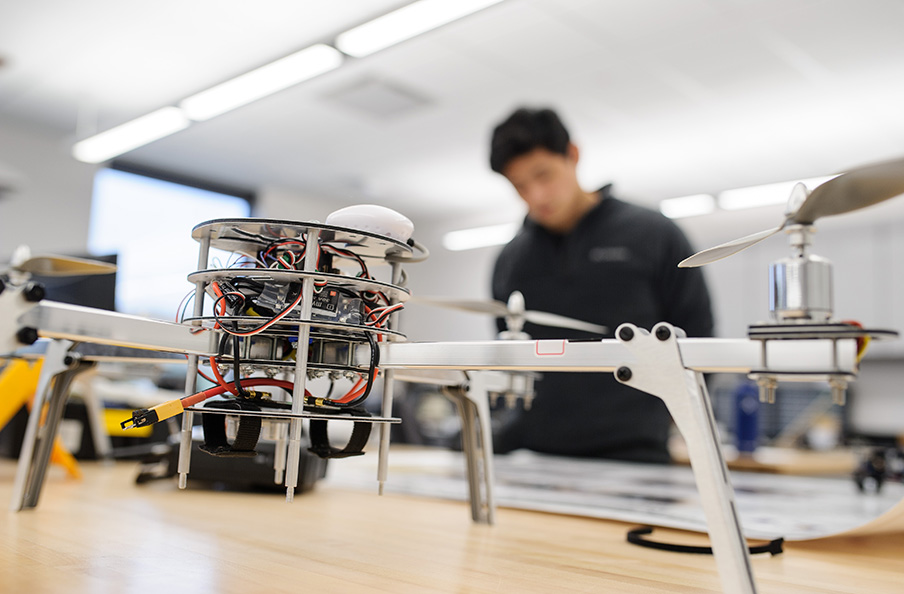
The College of Engineering offers a minor in robotics and provides a lab space to support this program. Some of the equipment housed in this lab include a hydraulic robotic arm; robotic vehicles, such as spiders and crawlers; and a mini humanoid robot named “Darwin.”
9. Chevron Center for Engineering Education (1269)
 The Chevron Center for Engineering Education is one of three studios that support
a university-wide program called Communication Across the Curriculum, which was started
in 2005 by a chemical engineering alum. The program focuses on improving four areas
of communication: written, spoken, visual, and technological, while deepening student
learning of course content. This space has 3D printers, large format printers, and
many electronic devices that students may rent to complete class projects. Students
who take the required number of communication-intensive courses and complete a senior
portfolio can graduate as a Distinguished Communicator. The College of Engineering
is proud to graduate the most Distinguished Communicators each year, thanks in large
part to this space and the professional staff who run it.
The Chevron Center for Engineering Education is one of three studios that support
a university-wide program called Communication Across the Curriculum, which was started
in 2005 by a chemical engineering alum. The program focuses on improving four areas
of communication: written, spoken, visual, and technological, while deepening student
learning of course content. This space has 3D printers, large format printers, and
many electronic devices that students may rent to complete class projects. Students
who take the required number of communication-intensive courses and complete a senior
portfolio can graduate as a Distinguished Communicator. The College of Engineering
is proud to graduate the most Distinguished Communicators each year, thanks in large
part to this space and the professional staff who run it.
10. BIM Lab (2348)
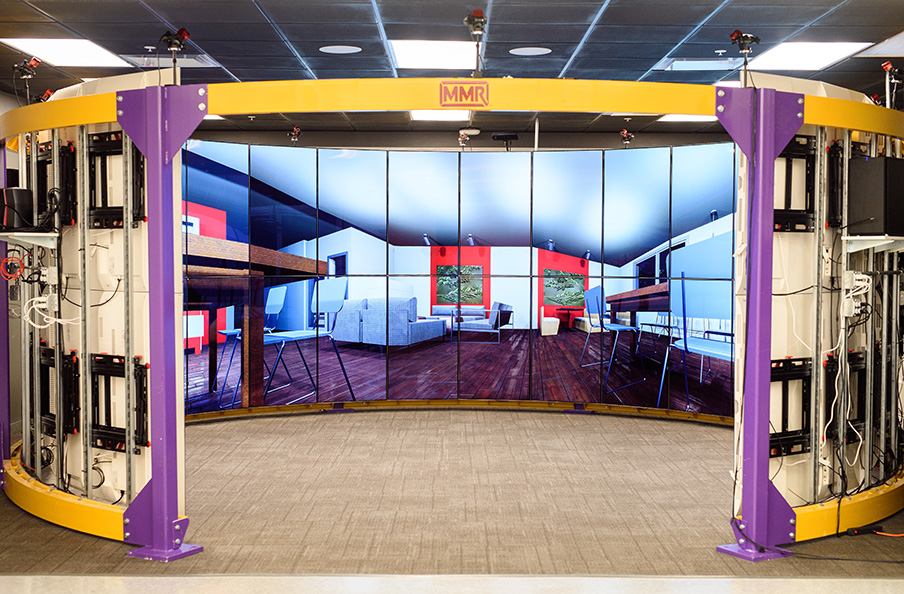 The MMR Building Information Modeling Laboratory is utilized by construction management
students and was specially designed and constructed by our faculty. The lab space
consists of 44 4K displays that allow for three-dimensional and computer-generated
views of building plans. This allows students and faculty to virtually visit building
sites to make assessments, alter plans, and consider concerns like safety and maintenance.
In addition to this unique lab space, the Bert S. Turner Department of Construction
Management has several labs and classrooms on the third floor, including an estimating
and scheduling lab, a room with several CATS equipment simulators, and an advanced
materials lab.
The MMR Building Information Modeling Laboratory is utilized by construction management
students and was specially designed and constructed by our faculty. The lab space
consists of 44 4K displays that allow for three-dimensional and computer-generated
views of building plans. This allows students and faculty to virtually visit building
sites to make assessments, alter plans, and consider concerns like safety and maintenance.
In addition to this unique lab space, the Bert S. Turner Department of Construction
Management has several labs and classrooms on the third floor, including an estimating
and scheduling lab, a room with several CATS equipment simulators, and an advanced
materials lab.
11. Proto Lab (2272)
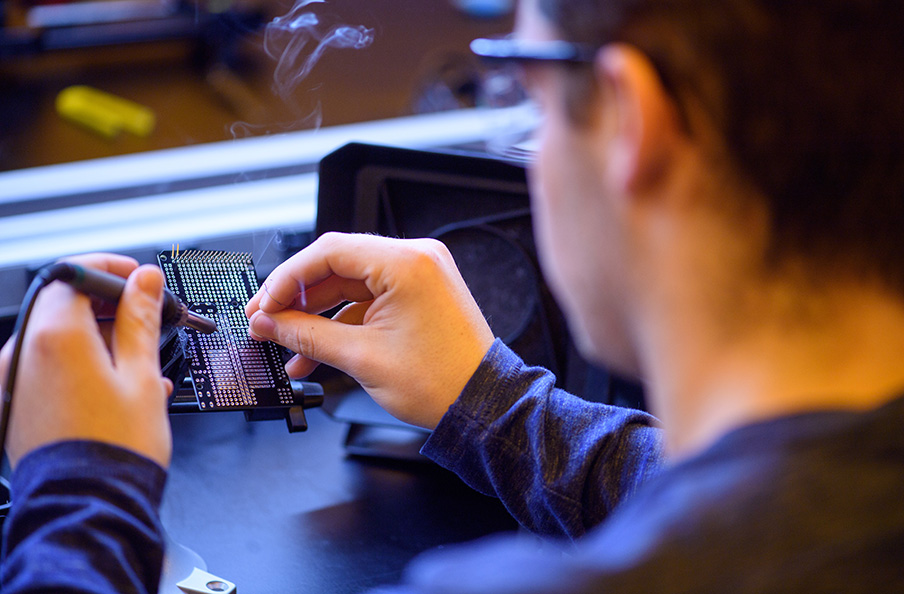 The Mark and Carolyn Guidry Electrical Engineering Laboratory Duplex houses a microprocessor
interfacing lab and a proto lab. This space is used by students to fabricate circuit
boards and create device prototypes. It is designed as a chemistry lab with fume hoods
to allow students to safely handle chemicals required for circuitry and is fully outfitted
with soldering stations, cutting machines, and 3D printers. Additionally, the lighting
and windows are designed to filter out UV light, which would interfere with the process
of layering circuit boards. This lab duplex was made possible by College of Engineering
alumni Mark and Carolyn Guidry, whose unique story is provided on the nearby purple
placard.
The Mark and Carolyn Guidry Electrical Engineering Laboratory Duplex houses a microprocessor
interfacing lab and a proto lab. This space is used by students to fabricate circuit
boards and create device prototypes. It is designed as a chemistry lab with fume hoods
to allow students to safely handle chemicals required for circuitry and is fully outfitted
with soldering stations, cutting machines, and 3D printers. Additionally, the lighting
and windows are designed to filter out UV light, which would interfere with the process
of layering circuit boards. This lab duplex was made possible by College of Engineering
alumni Mark and Carolyn Guidry, whose unique story is provided on the nearby purple
placard.
12. Annex/Drilling Fluids Lab (2147)
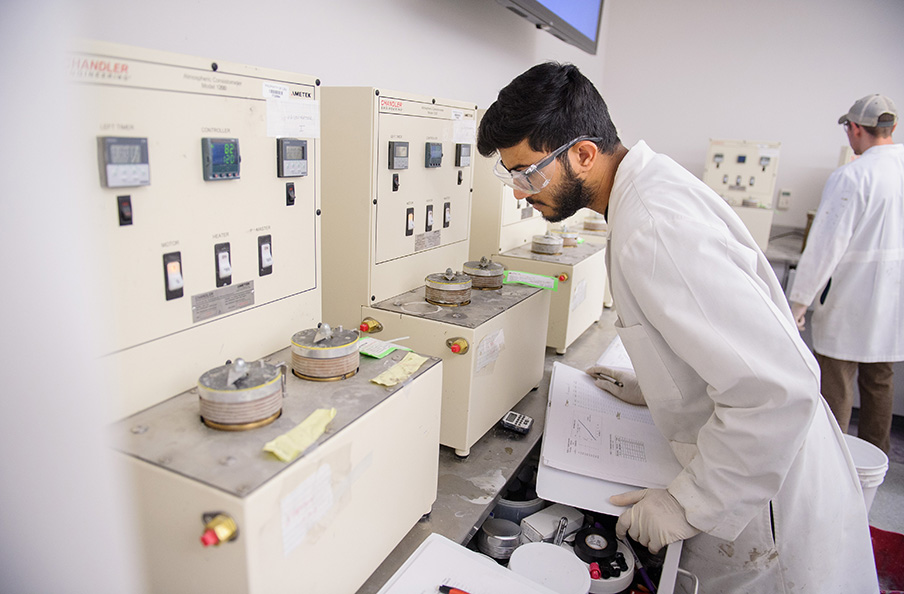 This hallway runs the length of the Chemical Engineering Annex – the portion of Patrick
F. Taylor Hall that was built “from the ground up” as part of the recent renovation
and expansion. The annex contains numerous chemical engineering laboratories, as well
as laboratories for construction management, civil engineering, environmental engineering,
and petroleum engineering spread throughout its three floors.
This hallway runs the length of the Chemical Engineering Annex – the portion of Patrick
F. Taylor Hall that was built “from the ground up” as part of the recent renovation
and expansion. The annex contains numerous chemical engineering laboratories, as well
as laboratories for construction management, civil engineering, environmental engineering,
and petroleum engineering spread throughout its three floors.
This particular petroleum engineering space is the Drilling Fluids Laboratory. Drilling fluids are the mixtures of water, clay, minerals and chemicals used by petroleum engineers to maintain pressure within a well, clean and lubricate drill bits and bore holes, and transport cuttings and debris to the surface. Since each well is unique, petroleum engineers must tailor the chemical and physical properties of drilling fluids to each well’s geology in order to control pressures and maintain safety. Petroleum engineers use many different methods and types of equipment to measure and adjust drilling fluids including mud balances, filter presses, and viscometers. This lab provides a space for students to gain hands-on experience with this type of equipment so they are well-prepared for work in the field.
13. Civil Engineering Driving Simulator Lab (2215)
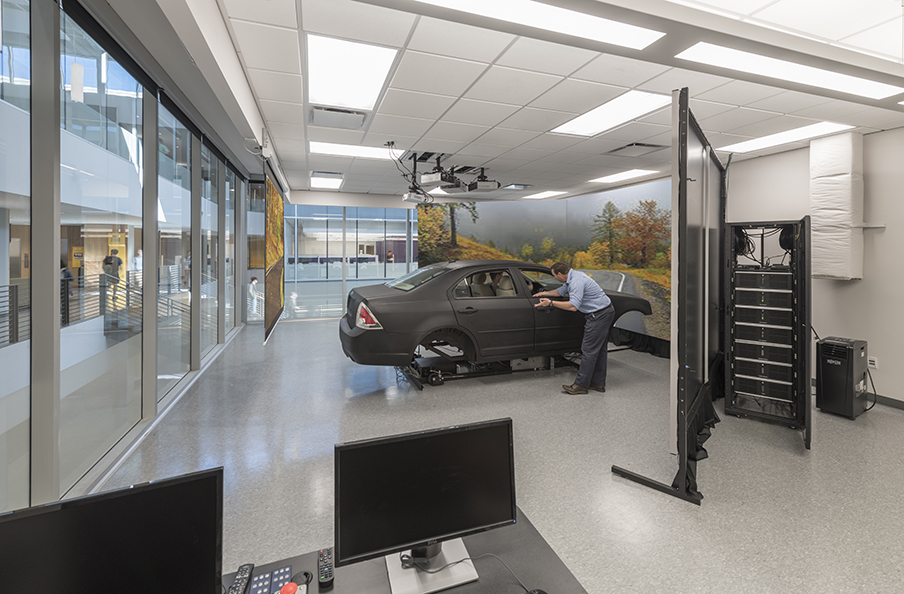 The Civil Engineering Driving Simulator Laboratory allows students and faculty to
research driving behaviors, environments, and traffic. Equipped with multiple screens,
projectors, and blackout curtains, this lab gives our researchers the ability to test
drive on new roadways and study drivers’ reactions to unexpected obstacles and events.
Recent research projects include the outcomes of distracted driving, the effects of
various weather conditions, and how drivers might interact with a semi-autonomous
driving system.
The Civil Engineering Driving Simulator Laboratory allows students and faculty to
research driving behaviors, environments, and traffic. Equipped with multiple screens,
projectors, and blackout curtains, this lab gives our researchers the ability to test
drive on new roadways and study drivers’ reactions to unexpected obstacles and events.
Recent research projects include the outcomes of distracted driving, the effects of
various weather conditions, and how drivers might interact with a semi-autonomous
driving system.
14. Brookshire Student Services Suite (2228)
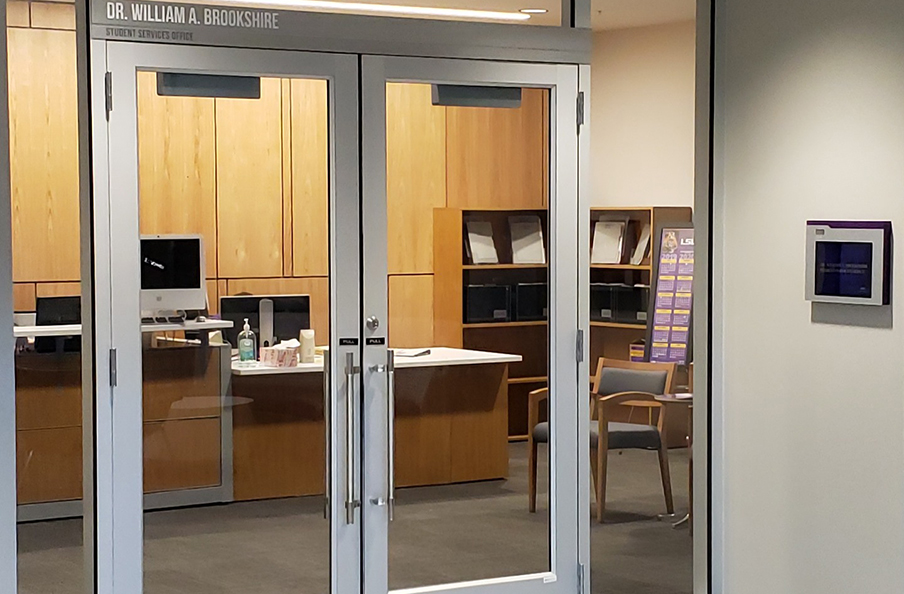 The Dr. William A. Brookshire Student Services Suite is a “go-to” first stop for most
students who have questions or need help with the administrative and academic demands
that come with being a college student. The Office of Student Services provides many
resources, as well as academic advisors, all of whom are licensed professional counselors,
to help with things like changing majors, adding a minor, and verifying how course
credits have transferred from other institutions. This suite also houses other professional
staff, including an engineering career coach, recruiting and outreach staff.
The Dr. William A. Brookshire Student Services Suite is a “go-to” first stop for most
students who have questions or need help with the administrative and academic demands
that come with being a college student. The Office of Student Services provides many
resources, as well as academic advisors, all of whom are licensed professional counselors,
to help with things like changing majors, adding a minor, and verifying how course
credits have transferred from other institutions. This suite also houses other professional
staff, including an engineering career coach, recruiting and outreach staff.
brookshire student services suite audio
We hope you’ve enjoyed this tour of Patrick F. Taylor Hall and learned some interesting and helpful information. To learn even more about the LSU College of Engineering, visit out our website at lsu.edu/eng.